

Article_23.pdf. Public Education. Discovery To begin preparing for trial, both sides engage in discovery .
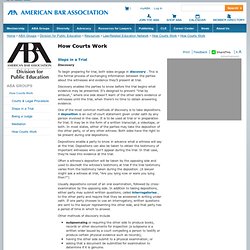
This is the formal process of exchanging information between the parties about the witnesses and evidence they’ll present at trial. Discovery enables the parties to know before the trial begins what evidence may be presented. It’s designed to prevent "trial by ambush," where one side doesn’t learn of the other side’s evidence or witnesses until the trial, when there’s no time to obtain answering evidence. DISCOVERY. 98.
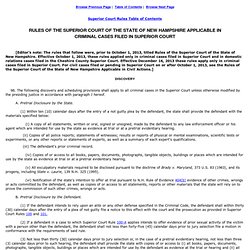
The following discovery and scheduling provisions shall apply to all criminal cases in the Superior Court unless otherwise modified by the presiding justice in accordance with paragraph J hereof. A. Pretrial Disclosure by the State. (1) Within ten (10) calendar days after the entry of a not guilty plea by the defendant, the state shall provide the defendant with the materials specified below:
DISCOVERY. Federal Rules of Criminal Procedure. (a) Government's Disclosure. (1) Information Subject to Disclosure.
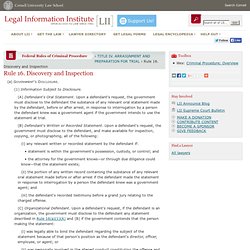
(A) Defendant's Oral Statement. Upon a defendant's request, the government must disclose to the defendant the substance of any relevant oral statement made by the defendant, before or after arrest, in response to interrogation by a person the defendant knew was a government agent if the government intends to use the statement at trial. (B) Defendant's Written or Recorded Statement. Rule 2.10. Discovery. Rule 2.10.
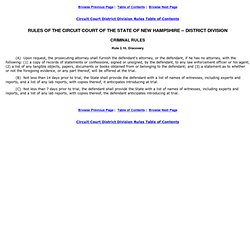
Discovery (A) Upon request, the prosecuting attorney shall furnish the defendant's attorney, or the defendant, if he has no attorney, with the following: (1) a copy of records of statements or confessions, signed or unsigned, by the defendant, to any law enforcement officer or his agent; (2) a list of any tangible objects, papers, documents or books obtained from or belonging to the defendant; and (3) a statement as to whether or not the foregoing evidence, or any part thereof, will be offered at the trial.
Rule 2.10. Discovery. Federal Rules of Criminal Procedure. (a) Government's Disclosure. (1) Information Subject to Disclosure.

(A) Defendant's Oral Statement. Article_23.pdf. The anatomy of a drug investigation. It's a game alive and well in Beatrice.

It's also a game that never ends, where the stakes are high and the consequences dire. Last month, the Beatrice Police Department and the Southeast Area Drug Enforcement (SEADE) task force completed a months-long undercover investigation into several suspected drug dealers in the Beatrice and Gage County area.... What Does a Drug Investigation Entail? - Attorneys.com. What Is the Goal of a Drug Investigation?
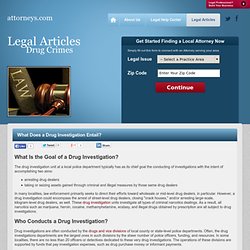
The drug investigation unit at a local police department typically has as its chief goal the conducting of investigations with the intent of accomplishing two aims: arresting drug dealerstaking or seizing assets gained through criminal and illegal measures by those same drug dealers In many localities, law enforcement primarily seeks to direct their efforts toward wholesale or mid-level drug dealers, in particular. However, a drug investigation could encompass the arrest of street-level drug dealers, closing "crack houses," and/or arresting large-scale, kilogram-level drug dealers, as well.
These drug investigation units investigate all types of criminal narcotics dealings. Who Conducts a Drug Investigation? Drug investigations are often conducted by the drugs and vice divisions of local county or state-level police departments. How Are Drug Investigations Conducted? Sex Offender Registration and Community Notification legal definition of Sex Offender Registration and Community Notification. Sex Offenses A class of sexual conduct prohibited by the law.

Since the 1970s this area of the law has undergone significant changes and reforms. Although the commission of sex offenses is not new, public awareness and concern regarding sex offenses have grown, resulting in the implementation of new rules of evidence and procedure, new police methods and techniques, and new approaches to the investigation and prosecution of sex offenses. Forcible Sex Offenses Forcible rape and Sodomy are sexual offenses that have been widely recognized since the beginning of American Common Law. Sodomy is defined as anal intercourse but is often used in the law as a generic classification including bestiality (sexual intercourse with an animal) and fellatio and cunnilingus (two forms of oral sex).
Sex Offender Registration and Community Notification legal definition of Sex Offender Registration and Community Notification. Criminal Law Resources: Fingerprint Evidence Challenges. In 1911, the first American court upheld a murder conviction based on fingerprint identification evidence.
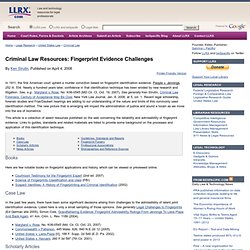
People v. Jennings, 252 Ill. 534. Nearly a hundred years later, confidence in that identification technique has been eroded by new research and litigation. See, e.g., Maryland v. Rose, No. A Brief History of DNA Testing New England Innocence Project. The use of genetic tests in forensics goes back a century to the discovery of blood typing.

But it wasn’t until the development of the first DNA fingerprinting techniques by Alec Jeffreys in 1984, followed by the development of PCR based methods, that such testing began to show its full potential. As these techniques became more widespread, research in the 1990s and 2000s improved on them significantly, extending the boundaries of their application to situations unimaginable only a few decades earlier. Click here to access reports and guides about DNA testingClick here to access materials about DNA testing from the June 17, 2011 Innocence Litigation TrainingClick here to access materials about DNA Mixtures and Contamination from the June 29, 2012 Forensic Science/Innocence Litigation Training.
Police Chief Magazine - View Article. By Raymond J. Prime and Jonathan Newman, Centre of Forensic Sciences, Toronto, Ontario, Canada he 20th anniversary of the first use of DNA1 to assist in a police investigation has passed without fanfare or recognition. In any other business, an event of this importance would have been saluted with public announcements and celebration; however, until the recent explosion of popularity of forensic science on television, the field commanded very little public attention. Nevertheless, the various applications of DNA analysis have cemented a binding partnership between police services and forensic sciences that has changed the justice system in a way that no other investigative tool has before.
DNA analysis has significantly improved police investigations by providing the potential to contribute to investigations in the following ways: Use of DNA Analysis in Identification, Health, & Human Origins. DNA Evidence: FAQs. Fingerprint Analysis: FAQs. Forensic Science Simplified: Funding Statement. 225321.pdf. How DNA Evidence Works. Technology has changed many aspects of the criminal justice system, and the use of DNA evidence represents one of the best examples of how technology has altered the criminal justice landscape. DNA, or deoxyribonucleic acid, is the basic building block of life. The information encoded in an organism's DNA acts as a blueprint for the organism's biological development and functioning. DNA exists in the cells of all living organisms, and by testing the DNA found in a person's cell, scientists can come up with a DNA profile for that individual. DNA profiling of individuals didnt even exist, however, until the mid-1980s, when an English scientist, Dr.
Alec Jeffreys, discovered that certain areas of the DNA strand contain patterns that repeat many times. RFLP is an accurate and reliable test, but it requires a relatively large amount of DNA to work. Science in court: The fine print. The Real Crime: 1,000 Errors in Fingerprint Matching Every Year. Nobody knows how many people sit wrongfully convicted in prison due to errors in fingerprint matching.
Forensic Science - Biological traces, Chemical traces, Physical evidence, Identification. Forensic science is a multidisciplinary subject used for examining crime scenes and gathering evidence to be used in prosecution of offenders in a court of law. Forensic science techniques are also used to examine compliance with international agreements regarding weapons of mass destruction. The main areas used in forensic science are biology, chemistry, and medicine, although the science also includes the use of physics, computer science, geology, and psychology.
Forensic scientists examine objects, substances (including blood or drug samples), chemicals (paints, explosives, toxins), tissue traces (hair, skin), or impressions (fingerprints or tidemarks) left at the crime scene. DefenseChallengeToFingerprints.pdf.pdf. What Is an Arrest? Police Arrests & Probable Cause. An arrest occurs when police officers take a suspect into custody. An arrest is complete as soon as the suspect is no longer free to walk away from the arresting police officer, a moment that often comes well before the suspect actually arrives at a jail. The U.S. Constitution’s Fourth Amendment authorizes an arrest only if the police have probable cause to believe that a crime was committed and that the suspect did it. This probable cause requirement restrains the power of the police to deprive people of liberty. It prevents the type of random roundup of “undesirables” that sometimes occurs in other countries.
Legislatures and courts have picked up where the Fourth Amendment leaves off, developing rules about how, when, and why people can be arrested. What Constitutes an Arrest? An arrest requires taking someone into custody, against that person's will, in order to prosecute or interrogate. To Interview or Interrogate — Know the Difference - Private Investigation. Interviews and interrogations are two very different things. Suspects are interrogated; witnesses are interviewed. Everything that follows can be applied to all types of investigations.
"Miranda" Rights and the Fifth Amendment. What are the "Miranda Rights"? Criminal Defendants' Rights During Trial: The Bill of Rights. The Bill of Rights provides certain rights to criminal defendants during trial. "Miranda" Rights and the Fifth Amendment. Hot Pursuit legal definition of Hot Pursuit. Warrantless searches special circumstances. Understanding Search and Seizure Law. Illegal Search and Seizure FAQs. Here are the most commonly asked questions regarding your rights when police search you, your home or your car. At what point are police considered "searching" during an investigation? Searches and Seizures: The Limitations of the Police. Although people in the United States are entitled to privacy and freedom from government intrusion, there is a limit to that privacy. State or federal police officers are allowed, where justified, to search your premises, car, or other property in order to look for and seize illegal items, stolen goods or evidence of a crime.
Search Warrant Requirements. Anyone who watches crime dramas on television is familiar with the scene where police officers enter a home or business brandishing a search warrant. The Fourth Amendment to the United States Constitution guarantees the people's right to be free from unreasonable searches and seizures, which often -- but not always -- means that government agents must have a warrant to search and seize your person and property. Search and Seizure. The Admissibility of Digital Photographs in Court.
By Steven B. Staggs. Basic Crime Scene and Evidence Photography Kit. Crime Scene Photography Kit The following items should be available to the crime scene photographer in order to photograph most scenes and evidence: CameraMost crime scene photographers use a high quality digital camera or 35mm camera. Digital cameras which have ten megapixel, or greater, image sensors and manual exposure settings (in addition to any automatic or programmed exposure modes) are usually suitable for crime scene and evidence photography. Normal lensA normal lens provides the best perspective for most photographs. Arriving at the Fire and/or Arson Scene: Processing Evidence at the Scene.
Examination and Documentation of the Crime Scene. Center for Problem-Oriented Policing. Microsoft Word - CrimeSceneInvestigation.doc - CSI Text Marilyn Miller.pdf. Evidence Technology Magazine - Documenting the Crime Scene.